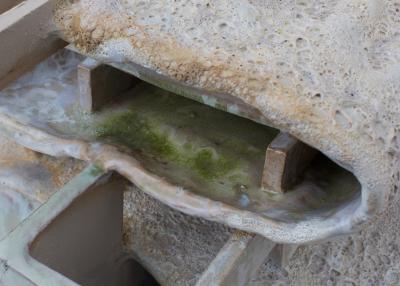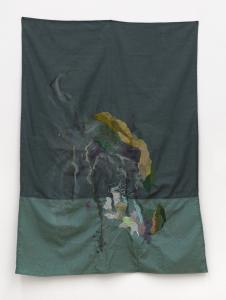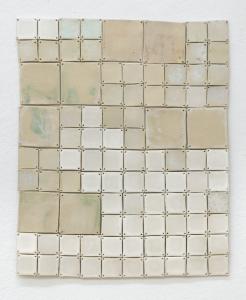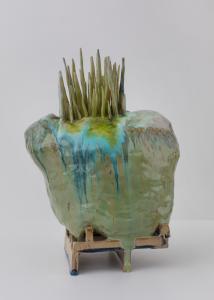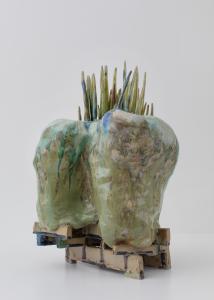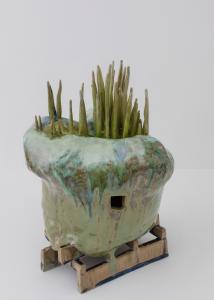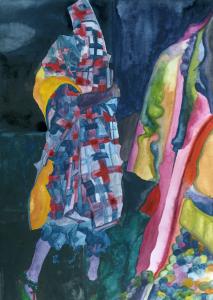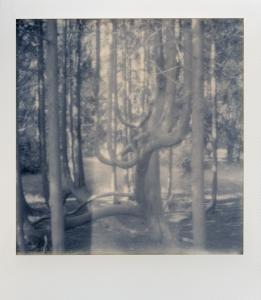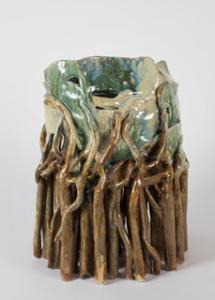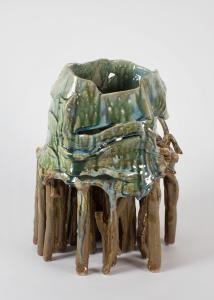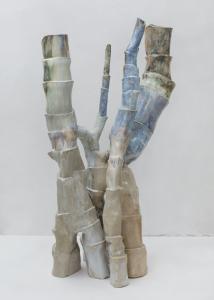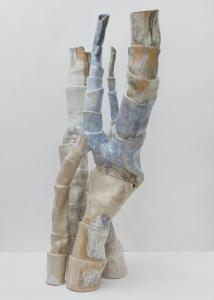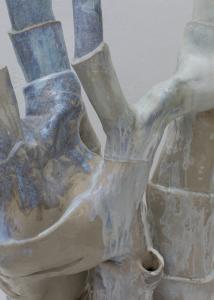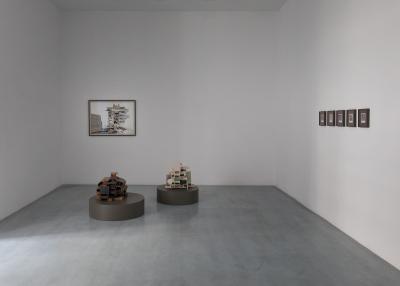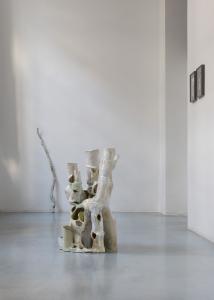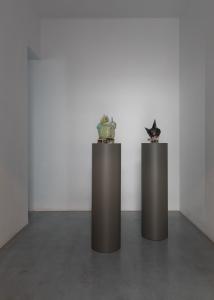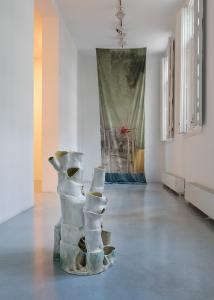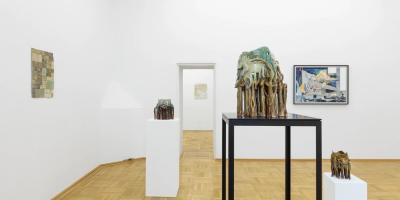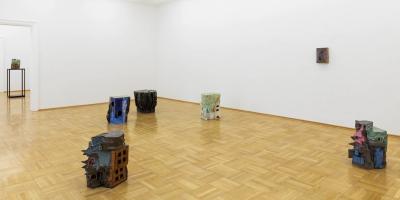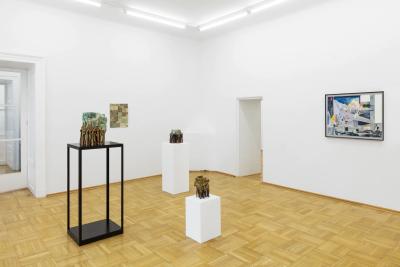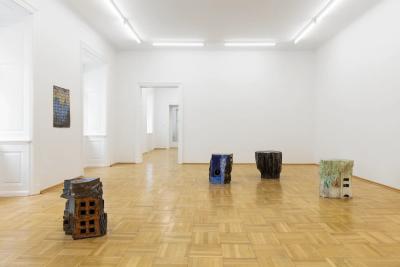Slow-Moving Architecture II,
Curtain (Botanic Garden/Forest),
Tuch (Lichen II),
Azulejos VII,
Habitat II,
Nr. 489,
If We Dissolve Now / We Are More Than We Ever Were I,
If We Dissolve Now / We Are More Than We Ever Were IV,
If We Dissolve Now / We Are More Than We Ever Were V,
Stilt House I,
Snake Grass IV,
If We Dissolve Now / We Are More Than We Ever Were
“De-differentiation” and “de-architecturization”: these are terms used by Robert Smithson in his work Hotel Palenque to refer to the way that built structures and organic growth, decay and renovation, ruins past and future, all merge ineluctably into an a-centric, entropic object-site-process on the site of a decrepit hotel in the encroaching jungles of the Yucatán peninsula. Moreover, Hotel Palenque, in its own shifting form — initially a live and witty lecture-cum-slideshow that the artist presented to a group of architecture students, a low-quality recording of which was later retrieved and reassembled after his death so as to be exhibited in museum settings around the world as an ersatz art work — echoes its subject matter: Hotel Palenque, like the Hotel Palenque, is a ruin in reverse, something does not fall but rather rises into ruin.
“De-architecturalization” and “de-differentiation” are also apt terms to consider in the context of Isa Melsheimer’s current exhibition at the Galería Benítez. Titled If we dissolve now / We are more than we ever were, the exhibition presents new works in various formats — ceramics, textiles and photographs — throughout which the intertwining of the inorganic with the organic and of stasis with flux functions both as motif and as concept. A number of the ceramics on view consist of rectilinear structures over and through which amorphous shapes seem to melt and surge and ooze — a kind of ‘de-architecturalization in which the apparently ‘natural’ world overtakes the built environment, as in an encroaching jungle or a bog’s rising water table — whereas in others the sequence seems to be reversed, where there is the suggestion that natural forms are propulsively acquiring engineered-like structural characteristics. The process conveyed by these works seems more reciprocal than juxtapositional. In a similar bidirectional fashion, Melsheimer’s gouaches depict movement via their content — not infrequently human figures in flight — while simultaneously embodying movement in their dynamic, fluid brushwork. And the textile-photographic works, with their literal conjoining of manual production and mechanical reproduction, maintain this sense of intertwined organic-inorganic synthesis.
To “de-differentiate” means to return something that was differentiated (at least to our experience) to an undifferentiated state: in a word, to dissolve. In this sense it functions as the operative principle throughout the works on view in the exhibition If we dissolve now / We are more than we ever were, where it is reinforced by the persistent references to nature, natural processes and, ultimately, to the earth (and what medium is more closely linked to the earth itself than ceramics, as Melsheimer’s ceramic work so exquisitely shows?). But nothing can dissolve into nothing. In terms of earth and earthly matters, the biosphere is a closed system. Anything that dissolves re-solves into something else. Ruins rise, ruins fall. As does everything, always.
Text: Georg Stolz
Continual Process of Improvement
Utopian architectural models, housing structures made by animals, buildings made of organic materials: once the chain of associations has begun, Isa Melsheimer’s new ceramic works invoke a host of possible identifications, scales, stories, and purposes. We see them as buildings despite the fact that these sculptures have only a few features that clearly designate them as such. They oscillate between fragment and model, between made and grown, between artificial and natural, frozen under a glaze that reminds us of efflorescences, oxidized rock, lichen, or sedimentary strata. Crystalline forms and lamellar parts meet unarguably architectural elements, while openings on the sides allow a view into the inner life of their construction reminiscent of structural engineering. Some of the monumental ceramics are almost waist-high; others are stretched out horizontally. In their arrangement in small groups, they suggest different types of housing developments in urban and rural spaces.
At first glance, the ceramic works fit seamlessly into the artist’s long-term exploration of our built environment, the conditions of its development and the changes in how it is judged. In this environment, cultural tastes, the zeitgeist of society, technological feasibility, visions of urban planning, economic arguments, and political will are manifested. Although a building is ostensibly associated with consistency and permanence, it undergoes a continual change after it is completed – not only in regard to its material qualities and outer appearance, but also concerning its aesthetic assessment. Nonetheless, an aesthetic judgement is often still decisive in the decision-making process for a building and overrides other arguments, like functionality or practicability. This is the background for Melsheimer’s new ceramics, which for the first time do not reflect concrete buildings or architectural styles, unlike her sculptures based on buildings designed by the architects Werner Kallmorgen, Ulrich Müther, and Heinz Islar or those in her work series Communication with the Rotten Past. Instead, they are based on her investigation of animal architecture, building structures made by animals. These are, for the most part, not built according to aesthetic criteria, but must fulfill other functions. They are also remodeled and adapted when needed and thus reflect a topical issue in the current architectural discourse surrounding sustainability in which, under the theme of repair, adaptations, additions, alterations, or repairs take the place of new buildings. Possible marks of time also have their place here and can be made productive as embedded elements that provide new incentives. When understood as a continual process of improvement, architecture no longer adheres to the idea of a fixed solution and instead opens itself up to becoming an architectural act that potentially is never finished.
Just as future demands on a building are unforeseeable, so are the actors who will someday react to it through adaptations and hence become co-creators. In their hybrid appearance located somewhere between model-like experimental arrangements of human dwellings and housing structures made by other creatures – or between human-made, animal-made, and grown – the ceramics suggest that this architectural process is located in a world that is no longer anthropogenic. Rather, the artist seems to be thinking about Donna Haraway’s age of the Chthulucene in which all possible species and creatures can exist and act collaboratively. Architecture in the Chthulucene would not be completed in terms of time or form and, as a sediment, would be a genuinely sculptural process, because it is additive. By incorporating non-human organisms, it would unveil previously unknown aesthetics, materials, and ideas of what constitutes a work. Isa Melsheimer’s ceramics hint at where this journey could take us.
Text: Verena Gamper


